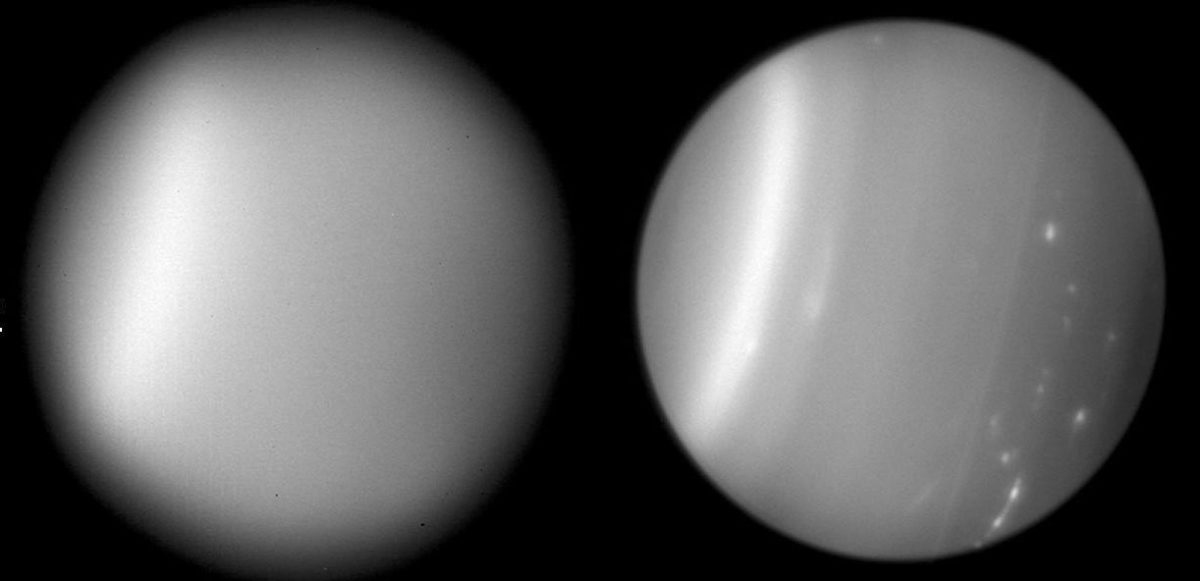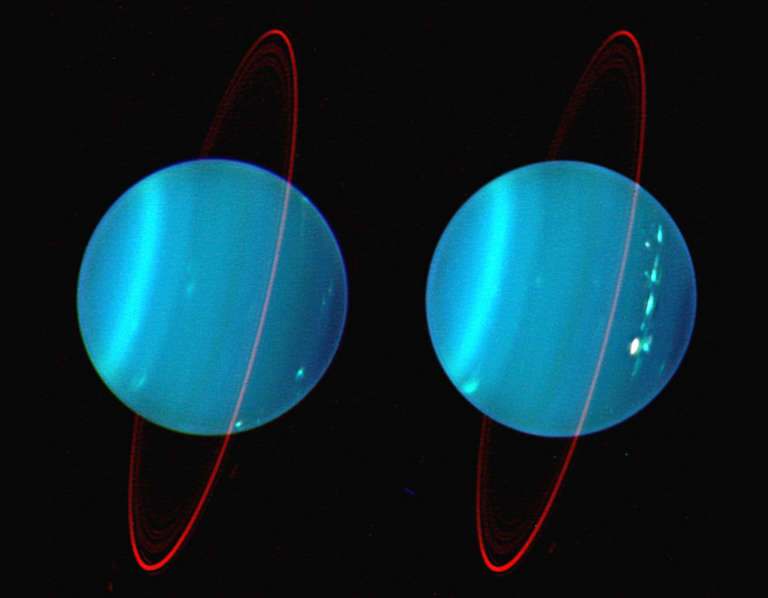Emily Lakdawalla • Nov 11, 2004
No Longer Boring: 'Fireworks' and Other Surprises at Uranus Spotted Through Adaptive Optics
This post was originally posted as a news article on planetary.org. It's one of my earliest pieces for The Planetary Society.
Uranus has the unfortunate reputation of being the most boring planet in the solar system. But where it appeared to be a nearly featureless, hazy blue ball to Voyager 2, it is now blooming dozens of clouds that are visible to the sharp-eyed Keck II Telescope. In fact, there are more clouds, moving faster, building larger structures, and changing shape more rapidly than any theorist expected.
"Records are breaking as fast as we can take data," announced Space Science Institute astronomer Heidi Hammel, one of three investigators who reported new results from Keck II observations at the American Astronomical Society’s Division for Planetary Sciences (DPS) annual meeting yesterday.
Keck II is outfitted with an Adaptive Optics system that dynamically changes the shape of the telescope's main mirror in order to reduce the blurring effect of the Earth's atmosphere. The images that can be produced with the Adaptive Optics system are stunning for their sharpness and clarity. What's more, with a ground-based observatory, astronomers have the luxury of repeating observations over long time scales. In all, "operating from the ground using Keck Adaptive Optics is a far richer experience than actually going to the planet," said University of Wisconsin astronomer Lawrence Sromovsky.

There is a lot of change going on at Uranus. First of all, the abundance of clouds has sharply increased since Voyager 2 flew by the planet in January 1986. Hammel stated that Voyager 2 saw a total of only ten cloud features anywhere on Uranus throughout its mission. But the more recent Keck Adaptive Optics observations have revealed at least 30 features that could be tracked over time, plus many more that appeared and disappeared on very short time scales.
One southern cloud, referred to as "the Great Spot at 37°S," or GS-37S, appeared to persist throughout the Keck observations, which took place from 2000 to 2004. Moreover, the cloud closely matched the position and general shape of one that had been spotted by the Hubble Space Telescope as early as 1996, and Sromovsky presented convincing evidence that the same cloud was actually seen by Voyager 2 during her flyby 18 years ago. At the same time, large clouds in the north bloomed and disappeared and bloomed again, forming an active band of features 18,000 kilometers (11,000 miles) long. Among these northern clouds were the northernmost yet seen on Uranus, and also the fastest-moving ever, with wind speeds of 229 meters per second (512 miles per hour).
Ordinarily, the clouds were visible through only two of the three color filters they employed on the Keck instrument. The third filter, known as "K prime," is sensitive to light at about 2.1 micrometers wavelength, where methane gas in Uranus' atmosphere strongly absorbs light. As a result of this strong absorption of light, images captured through this filter do not see very far down into Uranus' atmosphere. The other two filters, at shorter wavelengths, detect light in wavelengths where methane is not strongly absorbing, so they permitted the astronomers to see deeper into Uranus' sky. In general, the bright clouds were visible only through the two filters that probed into Uranus' deeper atmosphere, while the disk of Uranus appeared featureless in the K prime filter, indicating that the clouds did not reach to high altitudes.

But the GS-37S storm had a surprise in store for the observers when they returned to their observations on July 4, 2004. Hammel and her coworkers were surprised to spot the persistent storm in the K prime filter, where no storm had been visible before. The persistent storm "punched up like a thunderstorm to a high altitude," Hammel said. To their further surprise, the storm had again disappeared from view in the K prime filter by July 9, a performance that led Hammel to refer to the event as "Fourth of July fireworks." Imke de Pater of the University of California at Berkeley worked with Hammel on the Keck observations. "We have never seen such vigorous convective activity in the southern hemisphere before," she reported.
Hammel and de Pater suggested that the increased activity was due to Uranus' changing orbital geometry. Uranus is unique in the solar system for possessing a spin axis lying nearly in the ecliptic plane, which results in the most extreme seasons in the solar system. Voyager 2 flew past Uranus when the planet was near the height of southern summer; the entire southern hemisphere baked in continuous sunlight, while the north stared continuously at the blackness of space. Atmospheric scientists guessed that Uranus' featurelessness was a direct result of this geometry. The prevailing theory holds that a hood of photochemical haze covering the southern hemisphere sets up a stratified atmosphere that prevents convection. Convection, the motion of atmospheric masses that usually results from temperature gradients, sets up winds and storms on every other planet with an atmosphere, but hardly any storm activity has ever been observed at Uranus.
Now, 18 years later, the picture on Uranus is quite different; spring is coming to the northern hemisphere, and the inhibitions on convection appear to be gone. Hammel speculated that the activity might be setting up a northern band of bright clouds like the southern band that has been visible to Hubble for several years. But all Hammel, de Pater, and Sromovsky could offer to explain the observed changes were speculations, because there are at present no theories for the behavior of the Uranian atmosphere that account for the patterns of wind speed and cloud development that have been observed by workers on the Keck and Hubble telescopes. "Right now our observations are outstripping our theories," Hammel said, adding that it may be a while before theories are developed. "The theorists are all busy, focusing on Saturn. Eventually they'll come back to Uranus."

Fortunately, there is one area of Uranian science -- the rings -- for which the new Keck observations have been able to test existing theories, and collapse them to one successful explanation for ring behavior. Uranus' rings show up quite brightly and clearly in the Keck telescope's K prime filter, because even though the rings are very tenuous and difficult to detect, they are still far better scatterers of light at the 2.1 micron wavelength than is the Uranian atmosphere.
Over the period of the Keck observations, the rings have been closing up, as Uranus heads toward its equinox in 2007. De Pater studied how the apparent brightness of the ansae (the "handles," or extreme edges) of Uranus' rings changed between 2003 and 2004, and discovered that not only are the rings extremely flat, but in fact they form a "monolayer," meaning that they are everywhere only one particle thick.

What's the significance of this finding? "Physically and theoretically, a monolayer is not at all unreasonable," de Pater said. "But we have not seen this anywhere in the solar system before. Rings are usually spread out because of collisions and bending waves," making them several particles thick. At Saturn, for example, although the rings are known to be quite thin -- perhaps only 10 meters (33 feet) thick, that 10 meters of thickness contains lots of scattered tiny particles, and as Cassini observed during her orbit insertion, they can be tugged into vertical corrugations of 100 kilometers (60 miles) by the gravitational effects of small satellites.
In all, the consensus of the scientists presenting their results from Uranus was that there were strange and unexpected things afoot, and that the solar system's former wallflower is now blooming with activity.
Support our core enterprises
Your support powers our mission to explore worlds, find life, and defend Earth. You make all the difference when you make a gift. Give today!
Donate

 Explore Worlds
Explore Worlds Find Life
Find Life Defend Earth
Defend Earth

